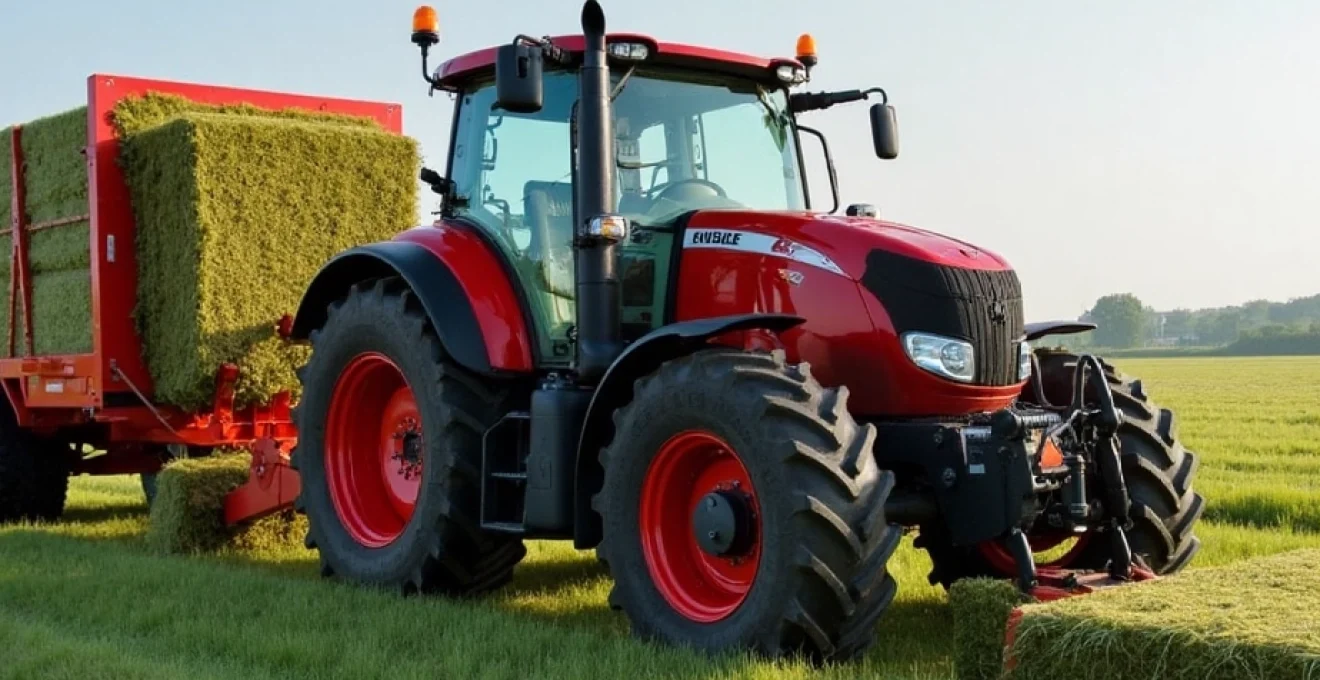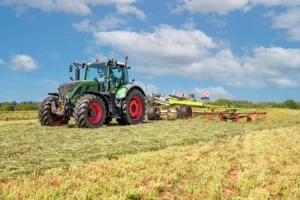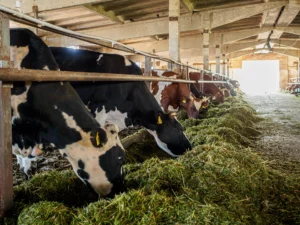
Selecting the right silage block cutter for long-stemmed grass is crucial for efficient livestock feeding operations. As farms grow and feeding demands increase, having a reliable and high-performance tool becomes essential. The ideal silage block cutter should effortlessly slice through dense, fibrous material while maintaining a clean, uniform cut to preserve silage quality. With numerous options available on the market, choosing the best cutter for your specific needs can be challenging. This comprehensive guide will explore the key features, top models, and critical factors to consider when investing in a silage block cutter for long-stemmed grass.
Understanding silage block cutters for Long-Stemmed grass
Silage block cutters are specialized agricultural implements designed to extract uniform blocks of compacted silage from bunker silos or silage pits. When dealing with long-stemmed grass, these machines face unique challenges due to the fibrous nature of the material. Unlike shorter, more densely packed silage, long-stemmed grass requires a cutter with enhanced cutting power and precision to maintain a clean face and minimize spoilage.
The primary function of a silage block cutter is to slice through the compacted mass of fermented forage, creating manageable portions for feeding or further processing. For long-stemmed grass, the cutter must be capable of cleanly severing the lengthy fibers without tearing or shredding, which can lead to increased surface area exposure and accelerated spoilage.
Modern silage block cutters come in various configurations, from simple attachments for front-end loaders to sophisticated self-propelled units. The choice depends on factors such as farm size, feeding frequency, and the specific characteristics of the silage being handled. For long-stemmed grass, particular attention must be paid to the cutting mechanism and power source to ensure optimal performance.
The Scie’Rex bucket with silage defacer for precision silage cutting is a perfect example of this new generation of advanced attachments. Designed by Emily Equipment, it combines cutting, loading, and feeding functions within a single, compact design. Its backward rotating rotor and patented hydraulic Soft Control System allow seamless adaptation to different machinery, while its reinforced Hardox structure ensures durability and precision. By producing a clean, smooth silage face, it minimizes spoilage, improves feed quality, and boosts overall efficiency in daily silage handling.
Key features of High-Performance silage block cutters
When evaluating silage block cutters for long-stemmed grass, several critical features contribute to their effectiveness and efficiency. Understanding these components will help you make an informed decision when selecting the best cutter for your operation.
Cutting mechanisms: circular saws vs. reciprocating blades
The heart of any silage block cutter is its cutting mechanism. For long-stemmed grass, two primary types are commonly used: circular saws and reciprocating blades. Each has its advantages and considerations:
- Circular Saws: These rotating discs provide a clean, swift cut through dense material. They excel at maintaining a smooth silage face, which is crucial for minimizing oxygen exposure and preserving silage quality.
- Reciprocating Blades: These back-and-forth moving blades offer versatility and can handle varying densities of silage. They are often more forgiving when encountering foreign objects but may result in a slightly less uniform cut compared to circular saws.
For long-stemmed grass, circular saws often have the edge due to their ability to cleanly slice through tough fibers without pulling or tearing. However, the choice may also depend on the specific grass species and silage density you’re working with.
Power sources: hydraulic, PTO, and electric options
The power source of a silage block cutter significantly impacts its performance, especially when dealing with long-stemmed grass. The three main options are:
- Hydraulic: Offers high power and precise control, ideal for heavy-duty cutting of dense, long-stemmed grass silage.
- PTO (Power Take-Off): Utilizes the tractor’s engine power, providing consistent performance and eliminating the need for separate power units.
- Electric: Less common but gaining popularity for its low noise and emissions, suitable for smaller operations or indoor use.
For most large-scale operations handling long-stemmed grass, hydraulic or PTO-powered cutters are typically the preferred choice due to their robust performance and ability to handle tough cutting conditions.
Blade materials: tungsten carbide vs. High-Carbon steel
The material composition of the cutting blades plays a crucial role in the longevity and performance of silage block cutters, especially when tackling long-stemmed grass. Two primary materials dominate the market:
Tungsten carbide blades offer exceptional hardness and wear resistance, maintaining their sharp edge for extended periods. This makes them ideal for cutting through abrasive, long-stemmed grass silage without frequent sharpening. However, they come at a higher initial cost.
High-carbon steel blades provide a good balance of durability and cost-effectiveness. While they may require more frequent sharpening when used on long-stemmed grass, they are generally more affordable and easier to maintain or replace on-site.
Cutting capacity and block dimensions
The cutting capacity and block dimensions of a silage cutter are critical factors in determining its suitability for your operation. For long-stemmed grass, consider the following:
- Cutting depth: Ensure the cutter can reach the full depth of your silage pit or bunker.
- Block width: Match the block width to your feeding system or mixer wagon capacity.
- Cutting speed: Look for a cutter that can efficiently process the volume of silage needed for your daily feeding requirements.
Remember that long-stemmed grass may require slightly larger block dimensions to maintain structural integrity during handling and feeding.
Top silage block cutter models for Long-Stemmed grass
After considering the key features, let’s examine some of the top-performing silage block cutter models specifically suited for long-stemmed grass:
Trioliet TU 195 XL: High-Capacity performer
The Trioliet TU 195 XL stands out for its impressive cutting capacity and robust construction. Designed to handle large volumes of long-stemmed grass silage, this model features:
- A powerful hydraulic cutting system capable of slicing through dense, fibrous material
- Extra-wide cutting width for efficient processing of large silage faces
- Adjustable cutting depth to accommodate various silo configurations
With its high-capacity design, the TU 195 XL is particularly well-suited for large dairy or beef operations dealing with significant quantities of long-stemmed grass silage daily.
Siloking DA 4200: precision cutting technology
The Siloking DA 4200 employs advanced cutting technology to ensure clean, precise cuts through long-stemmed grass silage. Key features include:
- A unique blade configuration that minimizes tearing and maintains a smooth silage face
- Automated cutting depth control for consistent block dimensions
- Optional integrated weighing system for accurate feed management
This model excels in producing uniform silage blocks from long-stemmed grass, contributing to reduced spoilage and improved feed efficiency.
Kuhn Primor 4270 M: versatility for various forage types
While specifically adept at handling long-stemmed grass, the Kuhn Primor 4270 M offers versatility for farms dealing with multiple forage types. Notable features include:
- A dual-rotor system that effectively processes both long-stemmed grass and other silage materials
- Adjustable cutting speed to optimize performance for different silage densities
- Large capacity hopper for reduced loading frequency
The Primor 4270 M is an excellent choice for operations seeking a single machine capable of handling diverse silage materials, including challenging long-stemmed grass.
Teagle Tomahawk 8550: Dual-Chop system for efficiency
The Teagle Tomahawk 8550 features an innovative dual-chop system that makes it particularly effective for processing long-stemmed grass silage. Key attributes include:
- A primary cutting mechanism for extracting silage blocks
- A secondary chopping system for further processing and even distribution
- Hydraulic folding sides for easy transport and storage
This model is ideal for farms looking to streamline their silage handling process, combining block cutting and distribution in a single unit.
Factors influencing silage block cutter selection
Choosing the right silage block cutter for long-stemmed grass involves considering several key factors specific to your operation:
Farm size and daily feeding requirements
The scale of your operation directly impacts the size and capacity of the silage block cutter you’ll need. Consider:
- Number of animals being fed
- Frequency of feeding
- Volume of silage consumed daily
Larger farms with high daily feeding requirements will benefit from high-capacity cutters capable of processing large volumes quickly, while smaller operations may prioritize versatility and ease of use.
Silage storage method: bunker vs. tower silos
Your silage storage method significantly influences the type of block cutter that will work best. Bunker silos typically require cutters with greater reach and cutting depth, while tower silos may necessitate specialized attachments or configurations. Ensure the cutter you choose is compatible with your specific storage setup.
Tractor compatibility and power requirements
For tractor-mounted or PTO-driven silage block cutters, compatibility with your existing equipment is crucial. Consider:
- Tractor horsepower and hydraulic capacity
- Lift capacity of the front loader or three-point hitch
- Attachment interface (e.g., Euro, SMS, or proprietary systems)
Ensure that your chosen cutter aligns with your tractor’s specifications to avoid performance issues or the need for additional equipment investments.
Maintenance considerations and spare parts availability
Regular maintenance is essential for optimal performance and longevity of silage block cutters, especially when dealing with abrasive long-stemmed grass. Consider:
- Ease of blade replacement or sharpening
- Availability of spare parts in your region
- Manufacturer support and service network
Opting for a cutter with readily available parts and strong local support can minimize downtime and maintenance costs over the long term.
Optimizing silage block cutter performance for Long-Stemmed grass
To maximize the efficiency and effectiveness of your silage block cutter when working with long-stemmed grass, consider implementing these best practices:
1. Maintain sharp blades: Regularly inspect and sharpen cutting blades to ensure clean cuts and reduce tearing of long fibers.
2. Adjust cutting speed: Experiment with different cutting speeds to find the optimal balance between efficiency and cut quality for your specific grass type.
3. Monitor silage moisture content: Excessively wet or dry silage can affect cutting performance. Aim for optimal moisture levels during ensiling and adjust cutting techniques accordingly.
4. Keep the silage face clean: Regularly remove loose material from the silage face to maintain a smooth cutting surface and reduce air infiltration.
5. Properly compact silage during storage: Well-compacted silage is easier to cut and maintains block integrity better, especially important for long-stemmed grass.
“Proper maintenance and operation of silage block cutters not only improves feed quality but can significantly extend the life of the equipment, providing a better return on investment.”
Cost-benefit analysis: investing in a quality silage block cutter
When considering the purchase of a silage block cutter for long-stemmed grass, it’s essential to conduct a thorough cost-benefit analysis. While high-quality cutters may have a higher initial cost, they often provide significant long-term benefits:
Improved feed efficiency: Clean-cut silage faces reduce spoilage and improve palatability, potentially leading to increased milk production or weight gain in livestock.
Time savings: Efficient cutters can significantly reduce the time spent on daily feeding tasks, freeing up labor for other farm activities.
Reduced waste: Precise cutting minimizes silage spillage and waste, maximizing the use of your valuable feed resources.
Lower maintenance costs: Well-built cutters with quality components often require less frequent repairs and have longer operational lifespans.
To accurately assess the potential return on investment , consider factors such as herd size, annual silage production, and current feeding inefficiencies that could be addressed with a new cutter.
“Investing in a high-quality silage block cutter tailored for long-stemmed grass can lead to substantial improvements in feed management efficiency and overall farm productivity.”
By carefully evaluating the features, performance, and long-term benefits of various silage block cutter models, you can make an informed decision that enhances your farm’s efficiency in handling long-stemmed grass silage. Remember that the best cutter for your operation will balance cutting performance, durability, and compatibility with your existing equipment and feeding system. With the right silage block cutter, you can streamline your feeding process, improve feed quality, and ultimately boost your farm’s productivity and profitability.

